Hoveringham St MichaelChurchyard
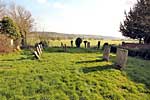 South-west corner of South-west corner of
the churchyard |
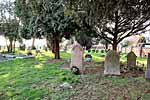 Churchyard extension Churchyard extension |
The church is surrounded by a roughly rectangular burial ground on all sides, and has an additional cemetery accessed by a gate in the south-west corner of the churchyard and a footpath leading directly from the main street alongside the village hall. This annex is substantial, extending behind the building now used as the village hall.
The north wall, set alongside the street pavement, rises about one metre in height and is mainly constructed of semi-dressed squared local mud-stone laid in irregular courses. A pair of wrought iron gates give access to the path leading to the north porch, the main entrance to the church. At the eastern end of this wall is an unused gate opening. The ground level within the church yard is higher than that of the street with the path cut through the ground creating banked sides. The path surface is gravel.
Each of the other boundaries is constructed differently. A low brick wall marks the eastern perimeter, whilst the southern boundary has three different methods of demarcation. The external wall of adjoining buildings leads from the north-east corner for about one third of its length, followed by a fence of slotted concrete posts and panels possibly enclosing the domestic garden of a dwelling. It then continues and is finally completed by a simple post and wire fence.
In the south-east corner of the main churchyard is the iron gate giving access to another section of burial ground. The west end boundary starts with is low brick wall and continues with a low hedge separating the church ground from the Village Hall. However, a path alongside the hedge within the latter site is the main access to the rear burial ground.
The graveyard extension is enclosed by a brick wall on the north and west sides and post and rail fences on the south and east boundaries.
Grave markers
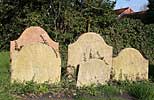 Grave markers Grave markers |
Most of the grave markers in the main church yard now lie flat. Virtually all markers have been removed from the eastern and northern sides of the burial ground. Some have been laid face upwards to form a path around the base of the church building. These are mainly of slate and where dates are visible they are from 19th century burials. Dates of 1837-1870s are visible. Some grave markers are still in situ and are clearly legible, others are flat and partially buried or naturalized by vegetation. At least one grave is identified as from the 18th century (1788). On the south side is a chest tomb commemorating Robert Rawlings. There are no obvious 20th century burials in this area.
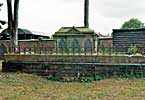 Nall family monument Nall family monument |
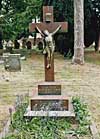 Tottenham grave Tottenham grave |
The current burial ground is an extension leading from the south-west corner of the above, but mainly accessed via an earth footpath which leads from the main street. It contains burials from the late 19th century through to the present time. At the western end there are a few markers dating from the 1880s. The major memorial commemorates the Nall family. This large structure is prominently located at the west end of the site where it terminates the slightly sunken central pathway. It is approximately 20 feet (5 m.) north to south and 8 feet (2.4m) east to west. The base is constructed using 6 courses of Staffordshire blue engineering bricks laid in English Bond, under a canted plinth of the same material. A limestone curb with a chamfered top sits on this base and is topped by low iron railings consisting of square uprights terminating in flat fleur–de-lis, with two rails between each upright, the top and bottom rail is a iron circle. Set with this surround is the memorial, an ornate limestone chest tomb with corner shafts of red/pink stone. The east face has three inset trefoil-headed panels bearing the inscriptions of the Nall family interments. There are seven names in total dating from 1871 to 1936. One person commemorated was not buried here, but in Sneinton Parish churchyard. Also within this part of the churchyard is an impressive red granite Calvary set on a three course plinth commemorating the Rev. Edward Tottenham who died in 1899.
There is also a tall obelisk of red granite in memory of George Clarke died 1912.
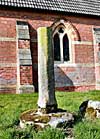 Sundial Sundial |
 Detail of sundial Detail of sundial |
In the older churchyard on the south side of the church is a Grade II Listed slender octagonal limestone column set on a round base, (possibly a cut down churchyard cross); on the flat top there is a sundial, this is also octagonal but not with sides of equal dimensions equal. It was possibly originally a square but has had the corners removed to produce an octagon. The shadow casting upright part of the equipment is missing as is part of the chapter ring. Roman numerals with I set in the conventional 12 o’clock position pointing due east to VIII in the conventional 5 o’clock position points south-west. The sequence of numbers appears to be repeated anti-clockwise with IIII pointing north-west. Part of the chapter ring that should show II and III is missing. There is no lettering between the two IIII’s in the western part of the chapter ring. Also in the old burial ground partially covered by vegetation and stacked against the east boundary wall are a few pieces of limestone which could have been part of the original church. Two pieces are either the capitals or part of the bases of shafts, both have flat squared sections with round mouldings. Another stone is a small square with ogee moulding, further stones are there but inaccessible under nettles and ivy.
|